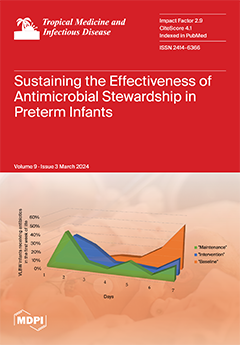Cutaneous leishmaniasis (CL) caused by
Leishmania aethiopica is transmitted by
Phlebotomus longipes in northern Ethiopia. No studies have been conducted to investigate the transmission dynamics of CL, despite its high endemicity in both rural and urban settings. Evidence on the ecology and behavior of the vector from this area are required to develop integrated disease control strategies. Sand flies were collected in the dry and wet seasons in 2021 in CL-endemic rural Gindmeteaye and urban Addis-Alem in northwest Ethiopia. Trapping was performed with sticky and Centers for Disease Control and Prevention (CDC) light traps in three habitats, including inside patients’ houses, peridomestic areasand in caves/rocky areas. Sand flies were morphologically identified to species level. Female
Phlebotomus species were categorized according to blood feeding status and tested by spliced-leader (SL-) ribonucleic acid (RNA) polymerase chain reaction (PCR) to screen for
Leishmania infection. Of 1161 sand flies, the majority (77%) were
P. longipes, six (0.5%) were
P. orientalis and the remaining were
Sergentomyia. The abundance of the 430 female
P. longipes was significantly linked to seasonality (
p < 0.001), with the majority in the dry season occurring in the outdoor rocky (37%) and peridomestic (34%) sites, while, in the wet season, most (62%) were captured indoors. This seasonality was more pronounced in rural Gindmeteaye, where housing construction is poor. The number of blood-fed and gravid
P. longipes was significantly higher in the wet (31%; 22%), compared to the dry season (13%; 8%), and their proportion was highest indoors. Eighteen (4%) female
P. longipes were
Leishmania positive, with highest infection prevalence in caves (7% compared to 3% indoors,
p = 0.022), and in the dry season (6%,
p < 0.001).
Phlebotomus orientalis specimens were all captured in May in rural Gindmeteaye, five indoors and one in a peridomestic site. Further research should be conducted to investigate the absolute contribution of humans and indoor transmission to the transmission cycle of CL. Inhabitants of endemic villages should be made aware that evening outdoor activities near caves may increase their exposure to infectious sand flies. Whether
P. orientalis can breed and become infected at high altitudes should be further studied.
Full article






